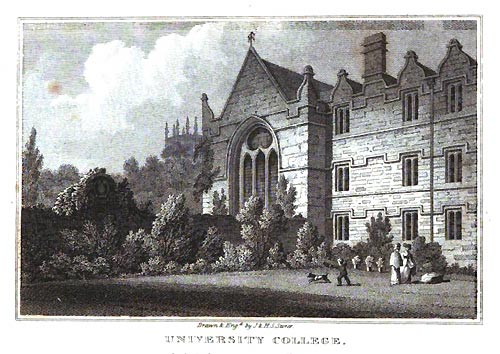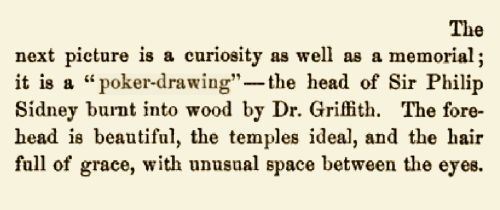E-Museum of Pyrographic ArtAntique Art Hall
|
| - Café Flambé - | - Portraits and Paintings - | - Decorative and Applied Art - |
| - Folk and Traditional Art - | - Antique Art - | - Special Hall - | - Sculpture - |
| - Children's Hall - | - Bookstore and Library - | - Tools and Techniques - |
 |
| University College, Oxford, England Digital image of an engraving of University College, Oxford |
According to Dr. Robin Darwall-Smith, Archivist of both Magdalen College and University College at Oxford in England, "Dr. James Griffith was elected a Fellow of University College in 1782, and then elected ... Master in 1808. He died in office in 1821..."
In regard to Elizabeth Grant's memoirs (see excerpt in the James Griffith section in the last (earliest) entry for the Nineteenth Century in the Antique Hall), Dr. Darwall-Smith noted that the "museum" mentioned in the autobiography, "means nothing" to them today: that "there has been no museum in University College for many years."
Three works by Dr. James Griffith (who was also referred to frequently as Rev. James Griffith)—the first an altar piece of Christ breaking the bread at the Last Supper, termed a Salvator Mundi; the second a portrait of King Henry IV; and the third a portrait of Robert Dudley, Earl of Leicester (both portraits of two benefactors to the College)—were found cited (with varying comments and in different contexts) in several Nineteenth Century documents as part of the collection of University College at Oxford. The first of these three works was presented by him for their College Chapel; his two portraits were destined for their Common Room.
A fourth work—a portrait of Sir Philip Sidney—was found cited only once in those early references, in the first excerpt (immediately following this introduction) where it was said to be "in the Picture Gallery." Could this "Picture Gallery" be the "museum" referred to by his niece Elizabeth Grant in her memoirs?
Also worth noting is the date of publication of the first excerpt: 1806. That date implies that all four of his burnt works were done by or before 1806 (i.e., prior to his becoming director of University College) and that they were already on display, as they appear cited there, in the Picture Gallery, in the College Chapel, and (two) in the Common Room, respectively.

Sir Philip Sidney Critique
Excerpt from the 1853 book A Month in England
and the chapter entitled "A Day in Oxford," p. 152
By Henry Theodore Tuckerman, published by Redfield, 1853.
Following is an excerpt from the 1806 book Oxoniana: Or Anecdotes Relative to the University and City of Oxford by John Walker that cites the work of Rev. James Griffith on pp. 14–15:
"A gentleman of the University (the Rev. James Griffith) has most successfully practised a method of burning portraits in wood, which display great accuracy of design and delicacy of execution, and a force of chiaro oscuro, which has never been equalled. Besides the portrait of Sir Philip Sidney in the Picture Gallery, this gentleman has presented his society (University College) with a beautiful copy of the celebrated Salvator Mundi, by Carlo Dolce, burnt in wood, for an altar piece to their chapel ; and the portraits of Henry the Fourth, and of Robert Dudley, Earl of Leicester, two benefactors to the college, executed by him in the same manner, for their common room."
Following is a second entry with two excerpts from the 1808 book A New Pocket Companion for Oxford: Or, Guide Through the University ... by J. Munday, J. Cooke that cites three works on pp. 45–46:
"...The altar-piece is a copy of the Salvator Mundi, a celebrated painting of Carlo Dolce, burnt in wood, and presented by the Rev. James Griffith, a Fellow of the College...The bust of the Founder stands between the portraits of King Henry IV. and Robert Dudley, Earl of Leicester, two Benefactors to the College, burnt in wood, and given to the Society by Mr. Griffith."
Following is a third excerpt from the 1847 book A Hand-book for Visitors to Oxford by John Henry Parker that cites only the one work by Dr. James Griffith on pp. 143–144:
"The altar-piece is a curious copy of the Salvator Mundi of Carlo Dolce, burnt in wood, by Dr. Griffith, formerly master of the college."
The following fourth entry offers two excerpts from the 1820 book Travels Through England, Wales, & Scotland in the Year 1816 by Samuel Heinrich Spiker that cites the works of Dr. Griffith on pp. 26–27:
"...The altar-piece is a copy from a painting by Carlo Dolce, and burnt in wood by Dr. Griffith, the present master of the college. Dr. Griffith has invented a new mode of delineation ; he burns pictures in wood with a poker, which he heats to a greater or less degree of redness, in proportion as the tints are intended to be clear or dark ; and at a distance they seem executed with sepia....The Common Room is very elegant, and adorned with the bust of King Alfred, by Rysbraeck, with that of Pitt, and also with portraits burnt in wood by Dr. Griffith. At a small distance from the college, stands the very ancient church of St. Peter, the back part of which is built in the oldest Saxon style...."
Following is a fifth entry with two excerpts from the 1847 book A new and popular pictorial description of England, Scotland, Ireland, Wales ... by Robert Sears that cites the one pyrography work of Dr. Griffith along with other contributions by him on p. 280:
"... "University College is remarkable for its antiquity. It is entered by a large quadrangle, a hundred feet square, which presents a noble appearance. The chapel and hall, on the south side, have undergone considerable characteristic and judicious alterations, after the designs of Dr. Griffith, a former master."
"The altar-piece is a copy of the Salvator Mundi of Carlo Dolce, executed by Dr. Griffith, the late master."
Following is a sixth excerpt from an internet compilation A Vision of Britain Through Time that cites the one work of Dr. Griffith within the history of University College (enter the search word 'Griffith' to locate the relevant paragraph):
"...The chapel also is on the S side of the W court; was built in 1665, and reconstructed in 1861; has a fine groined Gothic ceiling, and some curious windows; and contains a screen by Gibbons, and an altar-piece after Carlo Dolce, burned in wood by Dr. Griffith."
The seventh entry following has three excerpts from the 1813 book The Beauties of England and Wales, Or, Delineations, Topographical ... by John Britton, Joseph et al. that cites various contributions by Dr. Griffith in the chapter entitled Oxfordshire, page 216 and page 218 and page 219, respectively:
"The western quadrangle is a regular and handsome Gothic structure, 100 feet square. This part of the buildings was formed at different periods of the seventeenth century, under the direction of the Rev. Charles Greenwood. The chapel and hall are placed on the south side; and this division of the edifice is much indebted to the recent exertions of Dr. Griffith, the present master. The orignal centre of the facade was heavy, and devoid of character; Dr. Griffith has designed, and superintended the execution of, a bay window, finely Gothic, with a slightly-indented canopy on each side. His own chisel has, likewise, ornamented the moulding of the quadrangle with the heads of various benefactors, &e."
"...by carving attributed to Gibbons. The altar-piece is a Salvator Mundi, after Carlo Dolce, burned in wood (beech) by Dr. Griffith. This curious performance is surrounded by carving, supposed, like that in the screen, to be the work of Gibbons."
"In the Common Room is a fine bust of Alfred, by Wilton, from Ryabrach's model. This apartment is likewise, embellished by the portraits of King Henry IV. and Robert Dudley, Earl of Leicester, burned in wood by Dr. Griffith. Such a style of delineation is, perhaps, curious rather than desirable ; but there is a great portion of spirit infused into the latter piece..."
The task remains and research is underway to ascertain the whereabouts of the works cited. The altar piece is no longer there in the College Chapel, and, as Dr. Darwall-Smith noted, the museum cited is no longer in existence. The tiger described in Elizabeth Grant's autobiography may well refer to the one in the Pinto Collection in Birmingham.
UPDATE—March 2011:
In an 1868 English publication, entitled Notes and queries, is a topical thread on "Poker Drawing" that documents personal accounts sent in from readers with significant anecdotal information about some of the well known artists like Smith, Dr. Griffith, and John Cranch, as well as some additional recollections. The readership of this publication was significant in that the accounts are excellent, and even the Librarian at Knowlsley contributes to the discussion. Claims ascribed to Dr. Griffith were interesting and sometimes surprising.
If you have any questions or any information regarding these James Griffith works or others by this artist, please e-mail
the E-Museum Curator.

Excerpt from the 1853 book A Month in England and the chapter entitled "A Day in Oxford," p. 152
By Henry Theodore Tuckerman, published by Redfield, 1853.
"The altar-piece is a copy of the Salvator Mundi of Carlo Dolce, executed by Dr. Griffith, the late master."
"...by carving attributed to Gibbons. The altar-piece is a Salvator Mundi, after Carlo Dolce, burned in wood (beech) by Dr. Griffith. This curious performance is surrounded by carving, supposed, like that in the screen, to be the work of Gibbons."
"In the Common Room is a fine bust of Alfred, by Wilton, from Ryabrach's model. This apartment is likewise, embellished by the portraits of King Henry IV. and Robert Dudley, Earl of Leicester, burned in wood by Dr. Griffith. Such a style of delineation is, perhaps, curious rather than desirable ; but there is a great portion of spirit infused into the latter piece..."
You are leaving the Dr. James Griffith Salon
You can return to the
Antique Hall
or visit one of the following:
Pyrographic Art Exhibit Halls:
Portraits and Paintings
Decorative and Applied Art
Sculpture
Traditional and Folk Art
Children's Pyrographic Art
Special Pyrographic Art
The Book Store and E-Museum Library
Pyrography Tools and Techniques
Your questions and comments are welcome and appreciated.
Please e-mail the E-Museum Curator
Back to E-Museum Entrance homepage
© 2007, 2008, 2009, 2011 Kathleen M. Garvey Menéndez, all rights reserved.
Updated 4 November 2009. Updated 10 February 2011. Last updated 1 March 2011.

